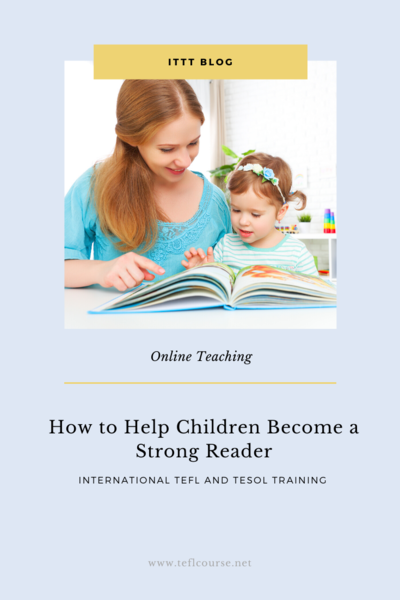How to Help Children Become a Strong Reader

As language acquisition through immersion goes, reading is positively amazing. Where movies may help with attitude and tone, reading allows us to see the words, form visual connections between them, and familiarise ourselves with spelling, punctuation, and structure. The best results, of course, are seen in readers who do it for pleasure, and for whom the point of reading is not simply to be done with it. How, then, do we get our children to read for fun when most of them seem to dread it?
Table of Contents
Step One: Drop mandatory/standardized reading
Step Three: Accept differences
Do you want to teach English abroad? Take a TEFL course!
This post was written by our TEFL certification graduate Smaranda E. Please note that this blog post might not necessarily represent the beliefs or opinions of ITTT.
Step One: Drop mandatory/standardized reading
There is no child for whom the benefits of mandatory reading will outweigh the damage. Obligation comes with expectations, standards, and the possible existence of a wrong way to do it. With the level of stress and pressure, our children are under nowadays, this is neither helpful nor efficient. Furthermore, because of the current structure of the education system in most countries where mandatory reading is common, "mandatory" also means "standardized". So, depending on their age, location, and approved school curriculum, all children in a class will be forced to read the same book at the same time, and there is a real possibility, seeing as they are individuals, that whatever material was chosen might communicate absolutely nothing to some, most, or all of the students. This is only made worse by the fact that, in the context of a literature class (often the origin of mandatory reading as a practice), the teachers are likely to push, knowingly or otherwise, a specific interpretation of the text, which brings us back to the absurd notion that there is a wrong way to read a book.
This cannot possibly make anyone love to read. The solution, then, is to get rid of mandatory reading, to the best of our ability. We should instead aim to help every child find stories that speak to them, and especially in the case of children who lost their love of reading as a result of exposure to this flawed system, start with short, level-appropriate books that win their trust without demanding a lot of time or energy.
Now that we've managed to get them to read at all, how do we keep that level of engagement up?

Also Read: Do I need a TEFL certificate to teach abroad?
Step Two: Make it social
Many adults think of reading as a solitary experience. But many children may be ill-equipped to handle extended periods of solitude, or may simply not want to, which could turn reading a book into a balancing act between how much they want to know what happens next, and how much they'd rather be doing something with another person. A child who has run into several books in a row that fails to strike this balance may thus conclude that reading is boring and not worth it.
Fortunately, the solution here is simple. We just have to make it a social activity, in any way we can. Most adults in charge of children naturally do this when the children are too young to read, by reading to them, and mistakenly believe there is nothing more to be done when the child becomes literate. But this is untrue.
One option is to keep reading to the child, but not continuously. We might establish a rule, such as "I will read you one chapter of this book every night before bed, but it will always be an odd-numbered chapter." This might motivate the child to fill in the gap by reading the appropriate even-numbered chapter sometime before bed, provided the book speaks to them. (An educator in charge of a small group could also do this if the chosen book appeals to the children they are in charge of.)

Also Read: "Online Teaching and Interacting with Parents"
Another option is to read at the same time as the child. (It could be the same book, but does not have to be.) For a lot of children who enjoy doing things with the adults in their lives, having a designated time and space to sit together and read can work wonders for their interest in it. We must not burden it with unnecessary restrictions, though. We should allow the child to comment on what they're reading, make jokes about it, or ask us questions. If the focus of the activity shifts from "reading with dad" to "sitting in a room with dad and making no noise", it won't work.
Children need to be allowed to express their interest in a book in more ways than just by reading it. We should ask them about it whenever we get the chance and listen to what they have to say. But we can't expect to ask "What's the book about?", and have them talk for half an hour, and then be done. It's more helpful if we engage continuously. We might ask who their favorite character is, and then ask what they think the villain wants, and then ask who they think stole the magical strawberry, and then ask if they think the dragon is being treated fairly. This is where reading the same book as the child is useful, as it helps us more genuinely engage with the material. We aim to communicate, through actions rather than words, that stories are to be loved and shared. They are not chores, and there is no limit to what they can mean.
Also Read: Equipment and Teaching Aids: How to Organize Your Class Properly
Step Three: Accept differences
We must be aware that even if we do the first two steps perfectly, not every child will end up reading 2000 pages a month. Reading simply does not suit everyone. Some people cannot turn words into images in their heads and will largely avoid books. Others just prefer movies. This is fine. If we can get at least most children to sincerely love at least one book, or even just have a sincere appreciation for the fact that it exists, as opposed to thinking of it as the enemy, we'll be doing better than we ever have.
Do you want to teach English abroad? Take a TEFL course!
Apply now & get certified to teach english abroad!
Speak with an ITTT advisor today to put together your personal plan for teaching English abroad.
Send us an email or call us toll-free at 1-800-490-0531 to speak with an ITTT advisor today.
Related Articles:
- Differences between Young Learners and Adult Learners in the TEFL Environment
- How Learning A Foreign Language Made Me a Better ESL Teacher
- The 5 Best Places to Learn French When Teaching English Abroad
- Top 5 Skills Teachers Need To Set Their Students Up For Success
- 4 Super Easy Tips for Teaching Vocabulary to Young Learners
- All the Documents You Will Need to Teach English Abroad




